Homeschooling can be challenging, and it becomes even more demanding when you are homeschooling multiple ages. Juggling different grade levels, abilities, speeds, and individual needs can seem overwhelming. But don’t fear!
In this blog post, we’ll supply you with ten indispensable tips to homeschool multiple kids successfully. Find your footing in this rewarding but demanding adventure and move forward bravely.
Let’s dive into the secrets of managing homeschooling with multiple kids!
*Note: This post contains affiliate links, which means I receive a small commission, at no extra cost to you, if you make a purchase using the link. Please see my disclosure for more details.

10 Quick tips for homeschooling multiple ages
Homeschooling multiple kids is not for the faint of heart. Even if you have an education degree and are used to having many children in your classroom, homeschooling multiple ages is completely different.
It will take longer than you think, and everyone will need you at once. Then there’s making sure they are all doing things correctly, and you will be quickly overwhelmed. When each child is doing something different, this task gets even harder. But it can be done!
To help with these struggles, here are my 10 quick tips for homeschooling multiple ages.

1. Be realistic
Just like with parenting, when you throw more than one kid into the mix, things get more difficult. If there are babies, it’s just mayhem. You must be realistic about what homeschooling will be like with multiple-age kids. It’s not easy.
I’m not saying this to scare you or keep you from homeschooling. I am saying this so you know what you are getting into. And to encourage you to take things slowly.
It likely won’t be sitting in a circle singing peacefully all the time. You may find some of that, but you will deal with a lot of chaos as well. It will also take time for everyone to adjust to new routines and changes.
Preparation, research, and planning for all of this will also take time. Keeping your days moving smoothly is worth it.
Anytime you think any of the “shoulds”, remind yourself that is probably not realistic. My kids ‘should’ be able to sit for 2 hours. My house ‘should’ be able to stay clean. This ‘shouldn’t’ take so long. Give yourself grace.
Just remember to be realistic with your expectations and your time. Homeschooling is not easy, especially with multiple kids. Knowing this upfront is good. Give yourself grace as you all adjust.
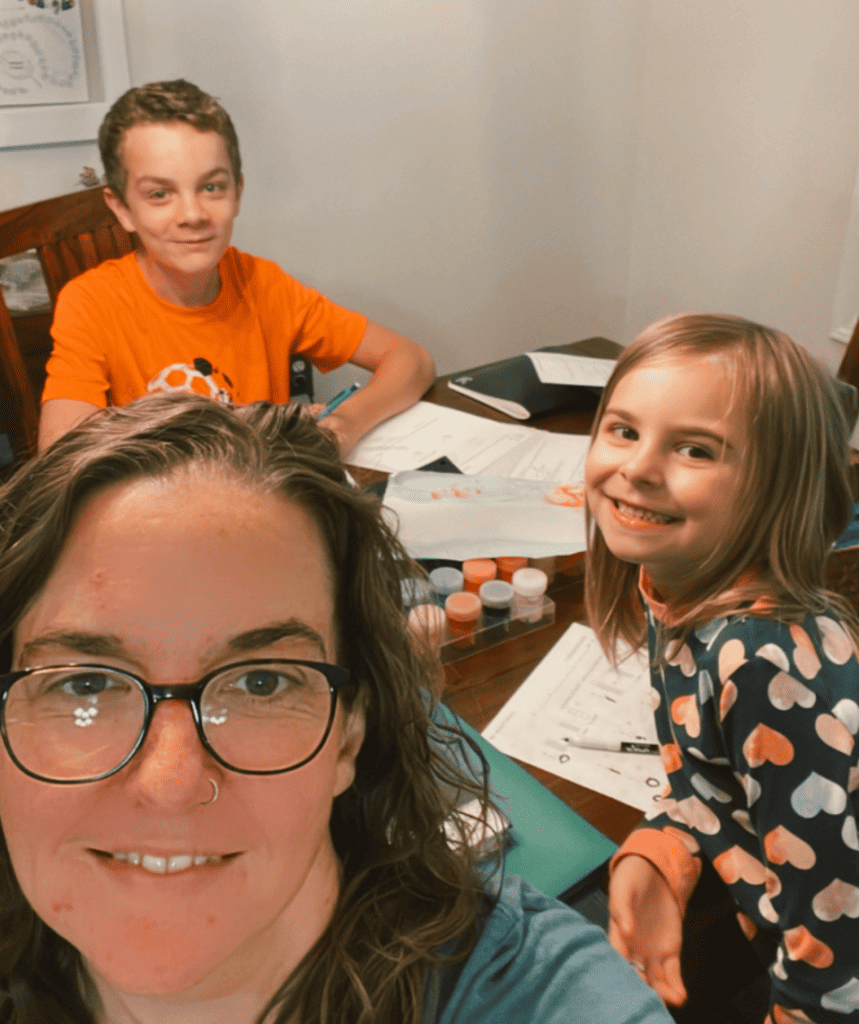
2. Do things together
When homeschooling multiple kids, do things together as much as you can. This will particularly be helpful with subjects that aren’t skill-building. Math and writing will likely be done separately. But most other subjects can be done together! Science and history are particularly good for multiple ages.
These subjects are great to do together:
- Science
- History
- Music history
- Art
- Bible
- Literature
Many of these subjects are easy to do as a group. This can save you a lot of time and energy. If kids are within a couple of years of each other, it will be easier to do it completely together.
If more than a couple of years, you can still do the base information together. Then you could assign a little more independent work or other assignments for your older child to expand on what you are learning together. You know your children and what they are capable of.
For more ideas on group learning, check out my post Morning Basket Made Easy: Group Learning in Your Homeschool.

3. Simplify curriculum
As moms who want the very best for our children, it’s so easy to fall into the mindset that we have to make school difficult and cover every topic known to man every year. But this is not at all necessary. And when homeschooling multiple ages, it likely won’t even be possible.
You need to simplify with multiple kids. You have years to teach them.
You may no longer be able to use the very hands-on curriculum you love. Or you might learn ways you can prep and adapt it so it will still work.
Finding time to look over several pages of math each day may be too much and you decide that someone else needs to do that, so you choose an online curriculum with grading included.
Simplifying may also mean doing the same things with several kids at once. Science and history are great to do together, and older kids will be able to easily add on extra books or activities to fill out their learning.

4. Teach independence
When homeschooling one child, you can easily spend all day right alongside them as they do their work. Even if you have kids close in age, this can be done. But when homeschooling multiple kids at different ages, you will quickly learn you can’t be in two places at once thinking two different thoughts with your two different kids.
So you will need to teach some independence so your kids can still accomplish some work while you are working with your other child.
If needed, assign a little extra something you know they can do on their own. I am not normally a fan of busy work, but if you need a little something to keep your kids occupied for a bit to keep the peace, a little isn’t terrible.
But also it’s ok to give your kids a break while they wait too.
With early elementary, you will need to do most everything alongside them. You are setting the foundation at this point. They won’t be able to do much on their own. And that’s ok. Do a little with them then let them play.
But as your kids get older, they will slowly be able to do a little more on their own. Depending on the child, you may be able to have them do most of their work independently by 4th grade. But if nothing else, by the time they are in high school, typical children will likely be working completely on their own.
Also, don’t be afraid to let your older kids help with your younger kids. These are great life lessons that can absolutely be counted as school. They can play with the baby, chase the toddler, and help the first grader with math.
Teaching independence will take work on your part and purposeful intention. And of course, the curriculum you choose will play a major factor in this as well. Some curriculum is impossible for kids to do on their own.
This is just like anything else you have helped your kids learn. Like walking. First, they will be completely dependent on you, then eventually you can show them how to move their legs. You hold their hands as they walk around. Then you may have them walk a few steps on their own. Before long, they can do it all. But they will still like to stay close to Mom.
Dealing with distractions
A difficult thing to deal with when kids are working independently is distractions. Some can easily tune things out, while others will need to learn how to focus and keep working despite their surroundings.
Keeping your kids nearby so you can help keep them on task is often helpful. But for some, they just can’t manage to keep their hands or thoughts to themselves.
One way to help deal with this is to allow your kids space away from their siblings. They can work in the living room, outside, or in their own room. You don’t have to be at a desk or special table to homeschool.
While this may help get them away from their siblings, it may still be distracting to be around toys and things they’d rather be doing. A room that is not theirs may work better.

Playing quiet classical music may help some. Or white noise in the background may also help drown out noisy distractions. One of my kids works best with headphones on when others are in the room to really be able to focus well. As homeschoolers, we can allow these special tools.

5. Littles first
Homeschooling with little kids is quite difficult. Especially with toddlers that like to get into everything. You may get up in the morning and want to get started with schooling your older children quickly. But those littles will often require your attention first.
I’m not just talking about diapers and feeding. I’m talking about actual attention. Playing, singing, reading, and cuddling.
Toddlers and babies need a lot of attention. We all know this. And when they see you giving attention to your other children, they may feel a little jealous. So fill their cups first.
It is an amazing thing that giving 20 minutes of attention to play with a toddler first thing will keep them good to play on their own for a while after! Then you are free to work with your other children. I can’t say you won’t be bothered by them, but it will be easier.
Build it into your daily schedule.
And don’t be afraid to let your kids help each other! If you have older kids, they can help play and take care of the baby too. They are learning life lessons impossible to replicate.
Using a short educational TV show is also a tool you can use if needed. Just give them your attention first!
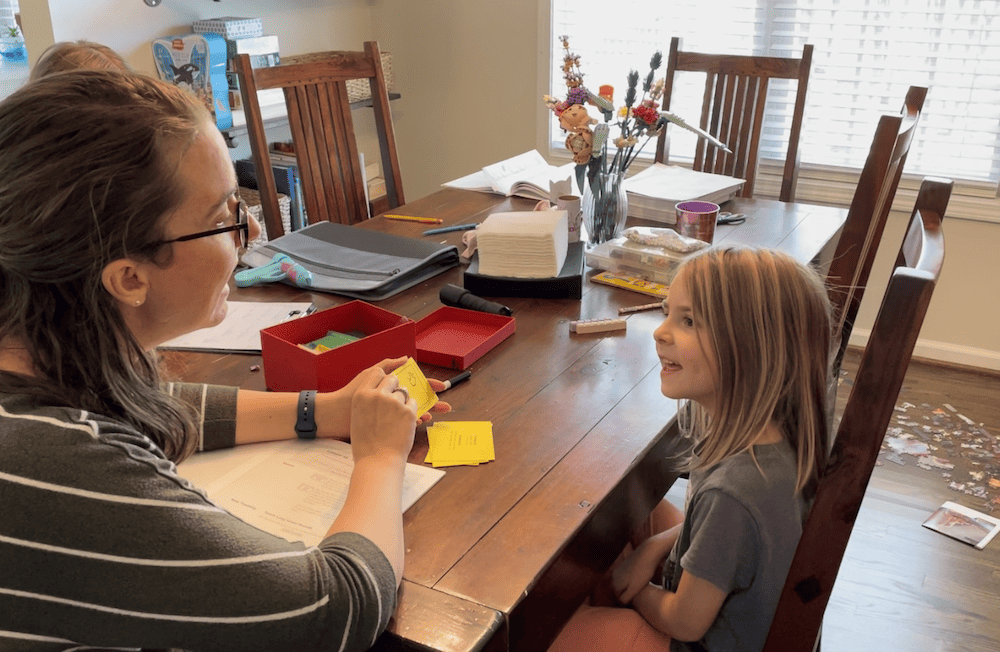
6. Give intentional attention
When you have a lot of places to put your focus, it can be difficult to feel like you ever can focus on anything. You will have to be intentional with your attention. Especially when it comes to your children.
You may do many things as a group, then each child works independently. They may only come to you if they need help. So be purposeful about giving one-on-one time.
You could sit with one of your children each day during independent time, helping as needed. Or work through everything with them. You could give this attention to a different child each day. Or you may choose to spend a smaller amount of time with each child every day.
This year, I decided to read a special book alone with each of my children. So after our group time each day, I spend 20 minutes with one child reading that book together and discussing it while the others start their independent work. Each day, I read with a different child. It has been really enjoyable. This way, we are getting to a book that’s specifically of interest to them and we are getting time together. Win-win.

7. Communicate expectations
It’s important to communicate with your children what your expectations are for the day. How they should behave. What they need to be doing and when.
One thing that is important to communicate is what your children should do when they need help but you are busy. Can they interrupt you? Do they need to wait until you’re done? If so, what do they do while waiting?
So think through your day. Create a daily schedule and homeschool routines. These will help you as you move into homeschooling. But remember these plans can always be changed.
Read: Creating a daily homeschool schedule that works
I currently have a first grader, so I spend a good bit of time working directly with her in our homeschool. During this time, my other two are supposed to be doing their independent work. If they get stuck on something, they are supposed to move on to another subject and ask me for help when I am available.
Of course, sometimes they interrupt anyways. The constant interruptions often lead to my frustration and a reminder to not interrupt. So I have to follow my rules too and remind them to wait up front.
Communicating these expectations in advance is necessary. They know what they should do, and you will be able to do what is needed.

8. Automate with a plan
Prepping curriculum can take a little time. You need to think about what books you will use, how many pages to do each day, and gather supplies. When you are doing this for kids of multiple ages, the time increases dramatically. I highly suggest you automate your days with a good advance plan.
Do all the big thinking in advance. At least days, if not weeks or months in advance. Come up with a plan of what to do and when. Then during the school year, not much thinking will be required except for implementing your plans.
We usually start our new school year in July. So in June, I spend a couple of days looking at our new curriculum. I decide how we are going to use it, how many pages of each to do a day, and prep what I can. I make supply lists, book lists, checklists, and schedules.
Remove the decision fatigue from your days. It may sound like a lot to do in advance, but batching it all together helps speed up the process!
Something I don’t do is assign anything to a date! Plans need flexibility and attaching a date to anything will very quickly make you feel “behind”.
If you’d like a process to plan out your school year in advance like this, check out my post How to create a homeschool plan that works for you.
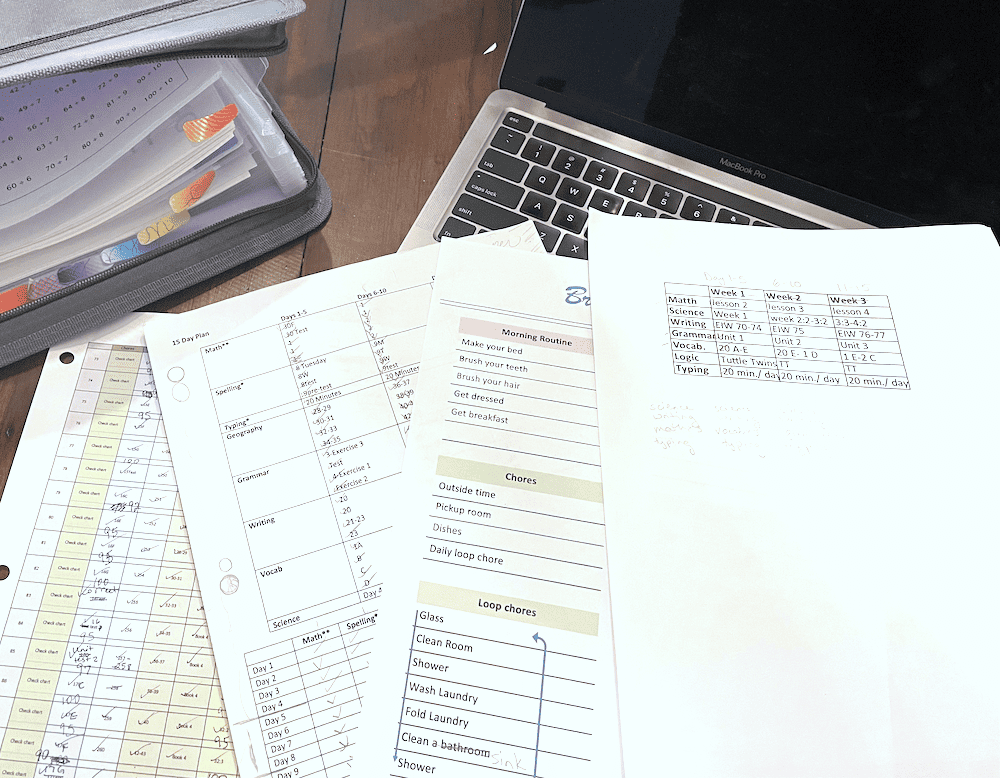
9. Use systems
There are many organizational systems you can use to improve your days while homeschooling multiple ages. These will simplify your days, give direction to your students, and help you be able to breathe through it all.
Folders and crates
Folders and crates are great ways to organize any worksheets you will have your kids do. Simply put worksheets into manilla folders organized by the week or day you plan to do them. You can put these folders into a crate. When that time comes, you just pull out the folder and all the worksheets are ready to go.
This can even be done with workbooks. Tear out all the pages and organize in advance, all subjects into one folder for the day.
Doing this is really helpful for giving some independence to younger kids. You won’t need to be there to be sure they are working on the right page of the book. They pull out the day’s pages and can get started without you.
You can prep these folders for a week at a time, a month, a semester, or even a year at a time.
Though I will note that the farther in advance you prepare these, the better chance there is you will get “behind”. If one lesson of one subject takes longer than you expected when you put the folders together, not only does that folder have the wrong pages, but every folder after it does too!
So prepping these folders no more than a month to 6 weeks in advance seems to work better at our house.
Lists and planners
Lists and planners are other systems you can use to organize your homeschool days with multiple ages. Just list out all the assignments you plan to do in a list. Each day, check the next item off until the list is finished. Some even put these lists into a planner so they can see what needs to be done each day.
Read: Best Paper Planners for Homeschoolers
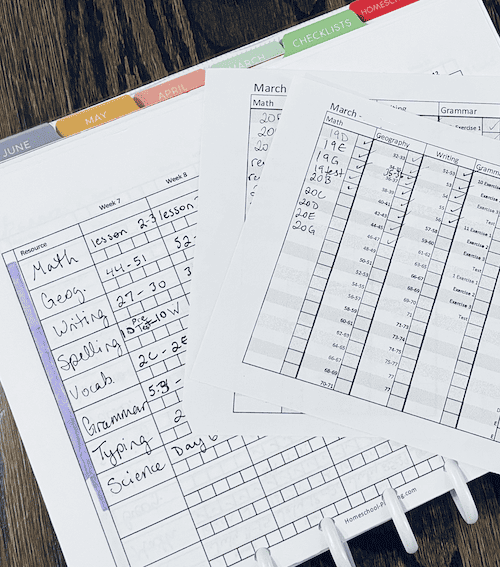
Using these lists will help you easily track what your kids are doing on any given day, and will guide you through your days reducing decision fatigue in the moment. Making these lists in advance will also help you to have more time and energy because you only need to check things off rather than write out each assignment as they are completed.
You can also make these lists and give them to your kids to have them check things off as they go. This is very helpful with older kids when you have multiple to homeschool. This way, you don’t need to get out their school work for them each day or keep track of what they did or didn’t do. It’s on them.
These lists can be made a week in advance – a month, a semester, or even a year in advance. You can assign each assignment to a date, or even a more general day of your school year. Like saying certain lessons will be done on day 82.
Once again, the farther in advance you prepare these lists, the better chance there is you will get “behind” in what you planned. Especially if attaching to certain days or dates. If one lesson takes longer than you expected when you made the list, the whole list will be off. If even one subject gets off, the whole list can be messed up.
So when attaching to days or dates, I suggest planning no more than a month to 6 weeks in advance.
Also, consider making digital lists that are easy to manipulate as needed. There are several digital homeschool planners that help you do this well.
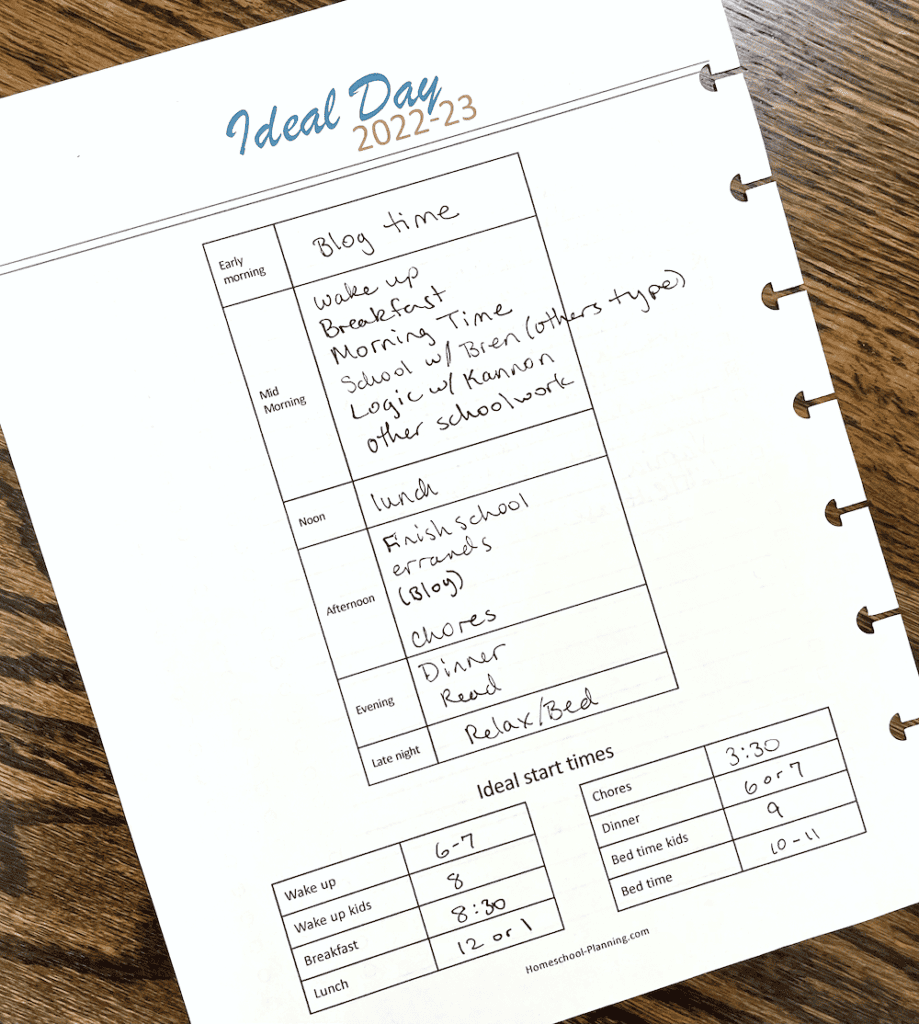
Schedules and routines
Setting up a daily homeschool schedule and routine is helpful not only for you but also for your kids. They give you structure to your days and will help you be able to make time for what is needed.
You may not think schedules work for you but stick with me for a minute.
If you think of a schedule in a more loose way, like a rhythm or flow of your day, you may be able to gain from it. Really it’s not about fitting more in, but rather knowing what is coming next. Deciding in advance a general flow for your day.
It will help you be less stressed and rest assured knowing you have made time for what is your priority.
Looping and blocking
Some great hacks to your homeschool schedule with multiple ages is to use blocking and looping. Let’s take them one at a time.
Blocking your schedule is when you block off an amount of time for one task. Often this is done by putting small tasks into blocks, often 15-30 minutes. But I like to think in bigger terms.
Block scheduling for homeschooling is helpful for larger chunks. Blocking out the whole morning for your homeschool time. Or using one whole day just to do science every week. Or doing a deep dive into a history topic for a whole week.
Blocking like this can help you get through a lot of work in a short amount of time, but it will also help you get deeper into it without task-switching and distractions. Blocking for larger general tasks will also help you pull in more flexibility to your homeschool time, where the order of the smaller items can be moved and flexed.
Looping is an approach to completing tasks in a list. If you have a list but only an hour to work within your day, then complete as much of that list within the hour. The next day you will start on the list where you left off.
When the list is completed, you loop back up to the top and go through the list again until your time is up. Loop around and around.
If your time is shortened one day, you can still get something done on your list. It just won’t be as much. If you miss a day completely, you haven’t missed anything on your schedule. There’s nothing to make up. You still just pick up where you left off.
Loops bring a little flexibility into your schedule. They’re great for accomplishing tasks you do every day, once a week, or any other time frame. They are great for cleaning schedules, homeschool time, one-on-one time with your kids, household projects, and menus.
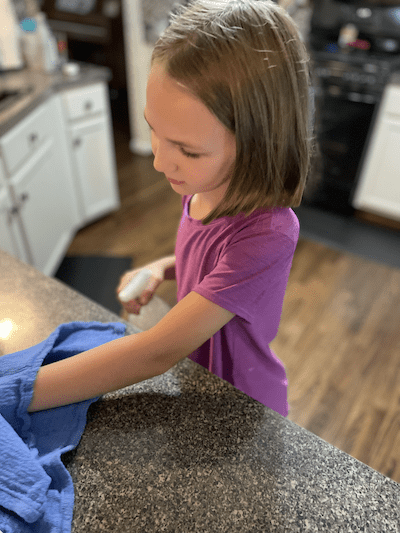
10. Delegate what you can
No matter what others tell you or what you think you should be (there’s that should again…), you are not Superwoman. Nor do you need to be. YOU DON’T HAVE TO DO IT ALL.
Homeschooling one child is a big job. Homeschooling multiple ages is even harder. All the planning, grading, checking, tracking, and records involved are tough to keep up with. Then you throw in cleaning, cooking, momming, and you’re already toast. That’s not even mentioning the actual time spent doing the homeschooling!
There are many things you can delegate in your homeschool. Cleaning and cooking can be delegated. But you can also hire a tutor or use an online class for a subject. Using a grading service can simplify some of the extra things.
One of the big advantages of homeschooling is that you have kids at home with you. It’s amazing what kids can do to help around the house. Littles are happy to help get things for you or throw something away.
As they get a little older, they can start sweeping and cleaning a little. Bigger kids can do dishes, help with cooking, take out the trash, help care for the baby, and even help a sibling with schoolwork!
Putting your kids to work will not only help you but also help them learn good skills for the future. A little extra time to teach them young will pay off when they can do things for you later.
Time is money, so these things will often cost money to delegate. Some are able to get creative in their efforts though. See if your mom can help with math, order groceries for pickup, and trade babysitting with a friend. Use a co-op or tutorial for some classes and an online writing curriculum.
Simplify your life and don’t be afraid to ask for help.
For more ideas on ways to get help from others while homeschooling, check out my post Household Chores Made Easy: How Moms Can Delegate Today.
Homeschool multiple ages
Homeschooling multiple ages can be a challenging task, but with the help of these ten essential tips, you’ve got this! Remember to keep things simple and realistic. Do as much as you can together and communicate your expectations. Spend time to make plans in advance and use systems to help you implement them smoothly. But never be afraid to ask for help!
Homeschooling can be hard, but everything you put into your children will be worth it!
Related Posts
7 Hacks for your Homeschool Schedule to save your Sanity
Design a Daily Routine Homeschool Schedule with a Free Printable!






